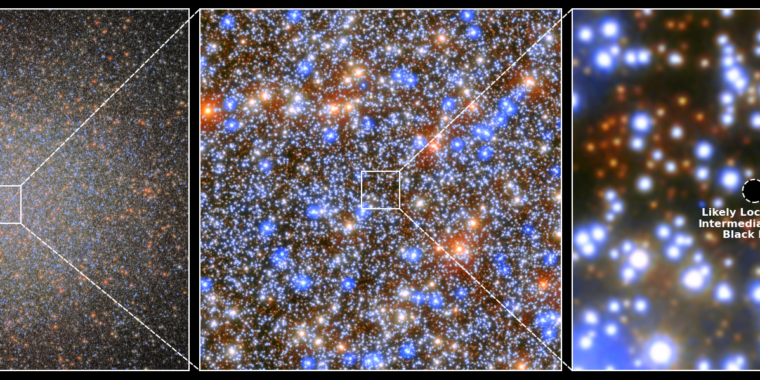ESA/Hubble & NASA, M. Hebel
Supermassive black holes reside at the centre of every galaxy and appear to have existed since galaxies formed. The early history of the universeHowever, at present we cannot fully explain their existence because it is difficult to understand how they could have grown so quickly to reach the criteria for supermassive stars.
Using nearly 20 years of data from the Hubble Space Telescope, researchers have recently found what may be evidence of this. The data, taken from a globular cluster thought to be the remnant of a dwarf galaxy, shows that a cluster of stars near the cluster’s center is moving so fast that it should have been ejected from the cluster entirely. This means that something massive is holding the cluster in place, and researchers claim that it is a rare intermediate-mass black hole with a mass over 8,000 times that of the Sun.
Rapid progress
The fast moving stars Omega Centauriis the largest globular cluster in the Milky Way galaxy. It is a dense environment with an estimated 10 million stars, but is relatively close at a distance of “only” 17,000 light years, making it easy to observe. These observations have suggested that there may be a black hole at the center of the globular cluster, but conclusive evidence is still lacking.
The new study, by a large international team, used more than 500 images of Omega Centauri taken by the Hubble Space Telescope over a period of 20 years. This allowed them to track the motion of the stars in the cluster and estimate their speeds relative to the cluster’s center of mass. This had been done before, but the latest data allowed for an update that reduced the uncertainty in the speeds of the stars.
In the updated data, several stars near the cluster’s center stood out for their extreme speeds. Seven of them were moving so fast that the cluster’s gravity would not be able to keep them there. All seven were expected to disappear from the cluster within 1,000 years, but there was a large degree of uncertainty about two of them. Given the size of the cluster, there should be no foreground stars between Hubble and Omega Cluster, so it appears that these stars are indeed within the cluster, regardless of their speed.
The simplest explanation is that there is additional mass holding them in place: it could potentially be multiple massive objects, but because all these stars are so close to the center of the cluster, it’s more likely to be a single compact object – a black hole.
Based on its speed, the researchers estimate the object’s mass to be at least 8,200 times that of the Sun. Some stars appear to be accelerating, and if this holds true for future observations, the black hole’s mass would be more than 20,000 times that of the Sun. That’s squarely in the realm of black holes, but smaller than supermassive black holes, which are roughly one million times the mass of the Sun or more. And black holes formed by the death of stars are rarely expected to be more than 100 times the mass of the Sun, so this black hole’s mass is significantly larger than that.
This falls into the category of intermediate-mass black holes, and such black holes are Few sightings reportednone of which are universally accepted. So this is an important discovery, if only because it may be the least controversial discovery to date of an intermediate-mass black hole.
What does this mean?
For now, there is still considerable uncertainty about some of the details, but there is hope that the situation will improve. Observations by the Webb Space Telescope could capture faint radiation from the gas falling into the black hole, and track the seven stars identified here. Spectroscopes could capture the redshift and blueshift of light caused by the motion of the stars. Being so far away from Hubble, it could also provide a more detailed three-dimensional image of Omega Centauri’s central structure.
Understanding this could tell us more about how black holes grow to supermassive scales. Previously, possible observations of intermediate-mass black holes have also been made in globular clusters, which could suggest that intermediate-mass black holes are a common feature of massive collections of stars.
But Omega Centauri is different from many other globular clusters, which often contain many star clusters that formed at roughly the same time, suggesting that it formed from a single, giant cloud of material. Omega Centauri contains star clusters with a wide range of ages, which is one reason it is thought to be the remnant of a dwarf galaxy that was sucked into the Milky Way.
If so, its central black hole would be an analogue of the supermassive black holes found in real dwarf galaxies, which raises the question of why it is only of intermediate mass: did the interaction with the Milky Way prevent the black hole from growing?
And ultimately, none of this explains how the black hole came to have such a massive mass, far greater than any star it is thought to have formed from. A deeper understanding of the black hole’s history may provide greater perspective on some of the questions currently vexing astronomers.
Nature, 2024. DOI: 10.1038/s41586-024-07511-z (About DOIs).


